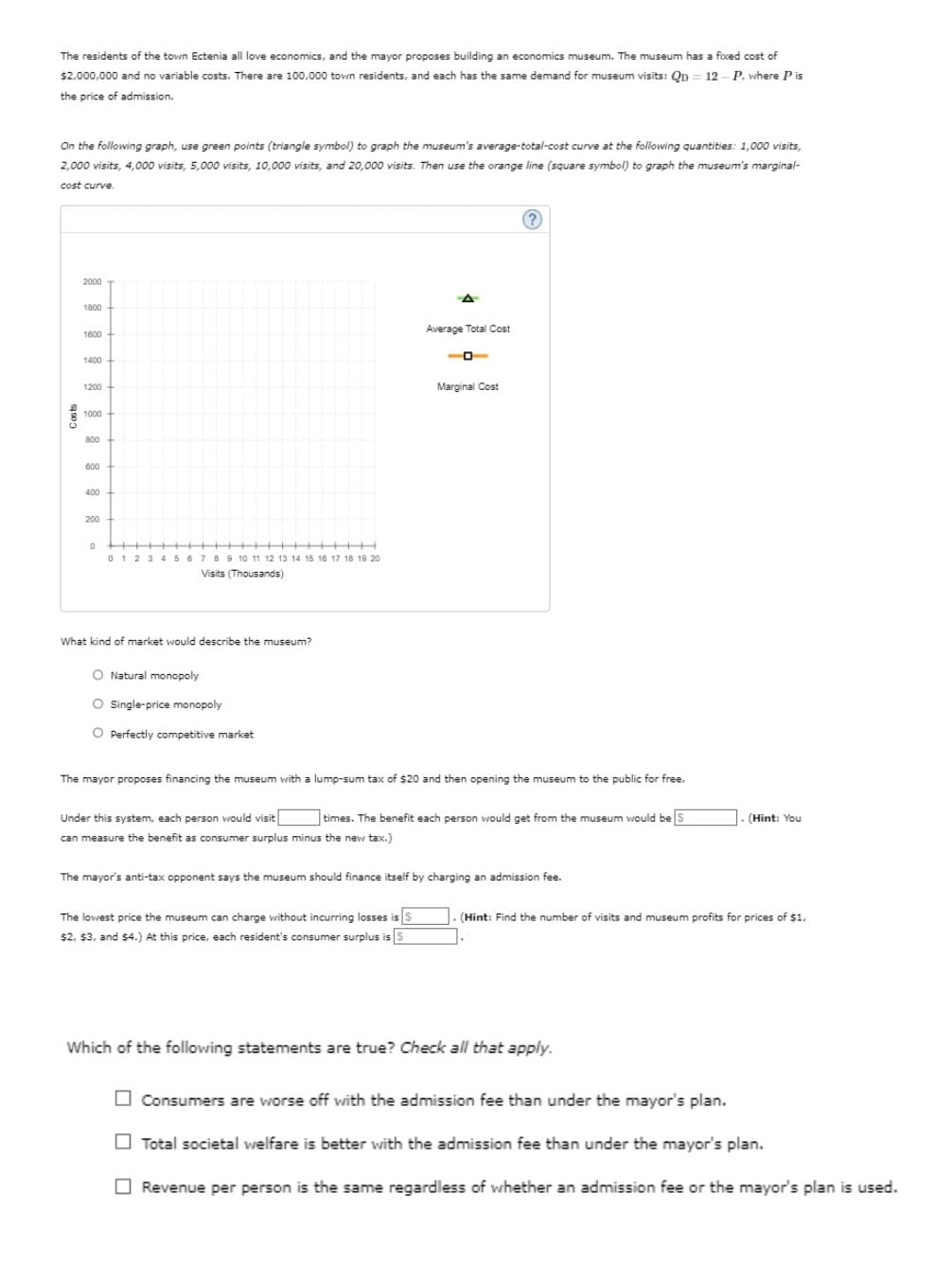The residents of the town Ectenia all love economics, and the mayor proposes building an economics museum. The museum has a fixed cost of $2.00000 and no variable costs. There are 100,000 town residents, and each has the same demand for museum visits: QD = 12 – P. vhere Pis the price of admission. On the following graph, use green points (triangle symbol) to graph the museum's average-total-cost curve at the following quantities: 1,000 visits, 2,000 visits, 4,000 visits, 5,000 visits, 10,000 visits, and 20,000 visits. Then use the orange line (square symbol) to graph the museum's marginal- cost curve.
The residents of the town Ectenia all love economics, and the mayor proposes building an economics museum. The museum has a fixed cost of $2.00000 and no variable costs. There are 100,000 town residents, and each has the same demand for museum visits: QD = 12 – P. vhere Pis the price of admission. On the following graph, use green points (triangle symbol) to graph the museum's average-total-cost curve at the following quantities: 1,000 visits, 2,000 visits, 4,000 visits, 5,000 visits, 10,000 visits, and 20,000 visits. Then use the orange line (square symbol) to graph the museum's marginal- cost curve.
Essentials of Economics (MindTap Course List)
8th Edition
ISBN:9781337091992
Author:N. Gregory Mankiw
Publisher:N. Gregory Mankiw
Chapter14: Monopoly
Section: Chapter Questions
Problem 7PA
Related questions
Question
sub= 24 help

Transcribed Image Text:The residents of the town Ectenia all love economics, and the mayor proposes building an economics museum. The museum has a fixed cost of
$2,000,000 and no variable costs. There are 100,000 town residents, and each has the same demand for museum visits: Qp
= 12 – P. vhere Pis
the price of admission.
On the following graph, use green points (triangle symbol) to graph the museum's average-total-cost curve at the following quantities: 1,000 visits,
2,000 visits, 4,000 visits, 5,000 visits, 10,000 visits, and 20,000 visits. Then use the orange line (square symbol) to graph the museum's marginal-
cost curve.
2000 T
1800
Average Total Cost
1600
1400
1200
Marginal Cost
1000
800
600
400
200
++++ H
012 3 4567 8 9 10 11 12 13 14 15 16 17 18 19 20
Visits (Thousands)
What kind of market would describe the museum?
O Natural monopoly
O Single-price monopoly
O Perfectly competitive market
The mayor proposes financing the museum with a lump-sum tax of $20 and then opening the museum to the public for free.
Under this system, each person would visit
times. The benefit each person would get from the museum would be s
- (Hint: You
can measure the benefit as consumer surplus minus the new tax.)
The mayor's anti-tax opponent says the museum should finance itself by charging an admission fee.
The lowest price the museum can charge without incurring losses is S
(Hint: Find the number of visits and museum profits for prices of $1,
$2, $3, and $4.) At this price, each resident's consumer surplus is S
Which of the following statements are true? Check all that apply.
O Consumers are worse off with the admission fee than under the mayor's plan.
O Total societal welfare is better with the admission fee than under the mayor's plan.
O Revenue per person is the same regardless of whether an admission fee or the mayor's plan is used.
Expert Solution
This question has been solved!
Explore an expertly crafted, step-by-step solution for a thorough understanding of key concepts.
This is a popular solution!
Trending now
This is a popular solution!
Step by step
Solved in 5 steps with 1 images

Follow-up Questions
Read through expert solutions to related follow-up questions below.
Follow-up Question
The residents of the town Ectenia all love economics, and the mayor proposes building an economics museum. The museum has a fixed cost of $2,000,000 and no variable costs. There are 100,000 town residents, and each has the same demand for museum visits: QD=12−P, where P is the price of admission.
What kind of market would describe the museum?
Single-price monopoly
Natural monopoly
The mayor proposes financing the museum with a lump-sum tax of $20 and then opening the museum to the public for free.
Under this system, each person would visit
times. The benefit each person would get from the museum would be
. (Hint: You can measure the benefit as consumer surplus minus the new tax.)
The mayor's anti-tax opponent says the museum should finance itself by charging an admission fee.
The lowest price the museum can charge without incurring losses is
. (Hint: Find the number of visits and museum profits for prices of $1, $2, $3, and $4.) At this price, each resident's consumer surplus is
.
Which of the following statements are true? Check all that apply.
Revenue per person is the same regardless of whether an admission fee or the mayor's plan is used.
Total societal welfare is better with the admission fee than under the mayor's plan.
Consumers are worse off with the admission fee than under the mayor's plan.
Solution
Knowledge Booster
Learn more about
Need a deep-dive on the concept behind this application? Look no further. Learn more about this topic, economics and related others by exploring similar questions and additional content below.Recommended textbooks for you

Essentials of Economics (MindTap Course List)
Economics
ISBN:
9781337091992
Author:
N. Gregory Mankiw
Publisher:
Cengage Learning

Economics (MindTap Course List)
Economics
ISBN:
9781337617383
Author:
Roger A. Arnold
Publisher:
Cengage Learning


Essentials of Economics (MindTap Course List)
Economics
ISBN:
9781337091992
Author:
N. Gregory Mankiw
Publisher:
Cengage Learning

Economics (MindTap Course List)
Economics
ISBN:
9781337617383
Author:
Roger A. Arnold
Publisher:
Cengage Learning
